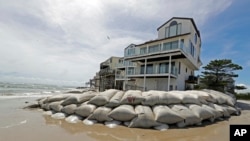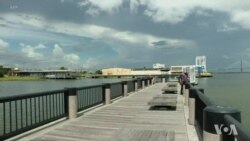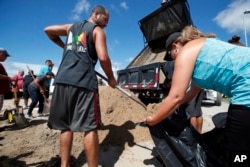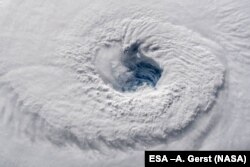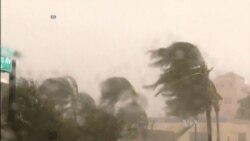President Donald Trump says protecting lives is his “absolute highest priority” as Hurricane Florence, now a Category 2 storm, sets its 40-kilometers-wide eye on the southeastern U.S. coast.
“We’ll handle it. We’re ready. We’re able,” Trump said Wednesday. “We’re fully prepared. Food, medical, everything you can imagine, we are ready.”
The president says he is in touch with the governors of North and South Carolina, the two states that are in the direct path of the storm.
And he has a concise message for anyone who plans to stay put and ride out the storm — “Don’t play games.”
WATCH: Officials Urge Evacuation Before Unpredictable Hurricane
Emergency officials have urged millions of residents along the southeastern U.S. coast to evacuate or hunker down.
“There will be disruptions in our services,” said the Federal Emergency Management Agency’s Jeff Byard said in Washington. “The power will go off. Infrastructure will be damaged. Homes will be damaged or destroyed. So, again, the time to act is now.”
“This is not going to be a glancing blow,” he said.
Officials are running out of words to describe Florence.
But they are not lacking words when urging people to get out of the storm’s path. They say coastal residents and tourists have one more full day — Thursday — to evacuate before Florence slams into the coast late Thursday and early Friday.
The storm’s current path shows Florence making landfall close to the North Carolina and South Carolina border. The governor of Georgia joined the Carolinas, plus Virginia and Maryland, in declaring states of emergency.
Florence has weakened a bit, and as of late Wednesday, it has been downgraded slightly to a Category 2 storm, with top sustained winds of 175 kilometers per hour (110 mph).
Forecasters at the National Hurricane Center are warning that as much as 101 centimeters (40 inches) of rain can fall on some parts of North Carolina with a storm surge of up to 4 meters — higher than many houses.
The president signed federal emergency declarations for the Carolinas and Virginia, a move that freed up federal money and resources.
More than 1 million people along the coasts of North and South Carolina and southern Virginia have fled. They have faced gas shortages at some stations, while those who have chosen to stay put are clearing store shelves of emergency supplies.
Along with the high winds and storm surge, forecasters are very concerned that Florence could be a slow-moving storm. It could linger along the Atlantic coast, dumping massive amounts of rain before drifting inland and bringing its heavy rainfall across the South and into the Mid-Atlantic by early next week.
Experts said this could be the strongest storm to hit the Carolina coast in more than 60 years.
The most powerful and only Category 4 hurricane in recorded history to hit the North Carolina coast was Hurricane Hazel in October 1954. Nineteen people in North Carolina were killed, and 15,000 homes were destroyed.
WATCH: Coastal Cities Call on Nature for Protection




